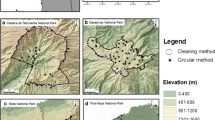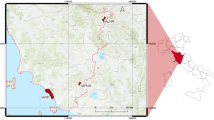Abstract
The European wild rabbitOryctolagus cuniculus (Linnaeus, 1758) populations in the Iberian Peninsula has suffered a serious decline. Therefore, the knowledge about the factors that influence rabbit distribution and abundance is of major interest for conservation and management programmes. Rabbit relative abundance was evaluated by pellet counting in relation to herbaceous ground cover, shelter availability (tall scrub cover and gaps in rocks) and land cover structure in the Peneda-Gerês National Park (PGNP), NW Portugal. Rabbit abundance was higher at intermediate levels of herbaceous cover, but no significant statistical differences were detected. A strong association between the abundance index and tall scrub cover was verified, and when this cover was rare, an association with gaps in rocks was observed. At the land cover level, rabbit abundance was associated with high interspersion sites of rocks with matorral and high interspersion sites of tall scrubland. Evidence from this study highlighted the importance of shelter and the interspersion of open/shelter habitats for rabbits. This pattern could be interpreted as an anti-predator strategy. Therefore, management actions should favour the growing and establishing of tall scrub patches and the selective cutting in highly continuous areas of tall scrub vegetation.
Similar content being viewed by others
References
Arthur C. P. 1989. Origine et histoire du lapin. Bulletin mensuel, Office National de la chasse 135: 13–21.
Banks P. B. 2000. Can foxes regulate rabbit populations? The Journal of Wildlife Management 64: 401–406.
Banks P. B., Dickman C. R. and Newsome A. E. 1998. Ecological costs of feral predator control: foxes and rabbits. The Journal of Wildlife Management 62: 766–772.
Banks P. B., Hume I. D. and Crowe O. 1999. Behavioural, morphological and dietary response of rabbits to predation risk from foxes. Oikos 85: 247–256.
Blanco J. C. and Villafuerte R. 1993. Factores ecologicos que influyen sobre las poblaciones de conejos, incidencia de la enfermedad hemorragica. ICONA, Madrid: 1–123.
Carvalho J. C. 2001. [Distribution and abundance of wild rabbit: influence of habitat quality and predators]. MSc thesis, Universidade do Minho, Braga, Portugal: 1–101. [In Portuguese]
Chapuis J. L. and Gaudin J. C. 1995. Utilisation des resources trophiques par le lapin de garenne (Oryctolagus cuniculus) en garrigue séche aménagée. Gibier Faune Sauvage 12: 213–230.
Delibes M. and Hiraldo F. 1981. The rabbit as a prey in the Iberian mediterranean ecossystem. [In: Proceedings of the World Lagomorph Conference (1979). K. Myers and C. D. MacInnes, eds]. University of Guelph, Ontario: 654–663.
Fa J. E., Sharples C. M. and Bell D. J. 1999. Habitat correlates of European rabbit (Oryctolagus cuniculus) distribution after the spread of RVHD in Cadiz Province, Spain. Journal of Zoology, London 249: 83–96.
Hardle W. 1990. Applied nonparametric regression. Cambridge University Press, Cambridge: 1–352.
Higgins K. F., Oldemeyer J. L., Jenkins K. J., Clambey G. K. and Harlow R. F. 1996. Vegetation sampling and measurement. [In: Research and management techniques for wildlife and habitats. Fifth ed., rev. T. A. Bookhout, ed]. The Wildlife Society, Bethesda, Md: 567–591.
Iborra O., Arthur C. P. and Bayle P. 1990. Importance trophique du lapin de garenne pour les grands rapaces provençaux. Vie Millieu 40 (2/3): 177–188.
Jaksic F. and Soriguer R. C. 1981. Predation upon the European rabbit (Oryctolagus cuniculus) in mediterranean habitats of Chile and Spain: a comparative analysis. Journal of Animal Ecology 50: 269–285.
Litvaitis J. A., Titus K. and Anderson E. M. 1996. Measuring vertebrate use of terrestrial habitats and foods. [In: Research and management techniques for wildlife and habitats. Fifth ed., rev. T. A. Bookhout, ed]. The Wildlife Society, Bethesda, Md: 254–274.
Lombardi L., Fernandez N., Moreno S. and Villafuerte R. 2003. Habitat-related differences in rabbit (Oryctolagus cuniculus) abundance, distribution and activity. Journal of Mammalogy 84: 26–36.
Martins H. and Borralho R. 1998. Evaluation of wild rabbit habitat selection (Oryctolagus cuniculus L. 1758) in a zone of the Center of Portugal by analysis of presence signs]. Silva Lusitana 6 (1): 73–88. [In Portuguese with English summary]
Martins H., Milne J. A. and Rego F. 2002. Seasonal and spatial variation in the diet of the wild rabbit (Oryctolagus cuniculus L.) in Portugal. Journal of Zoology, London 258: 395–404.
Moreno S., Villafuerte R. and Delibes M. 1996. Cover is safe during the day but dangerous at night: the use of vegetation by European wild rabbits. Canadian Journal of Zoology 74: 1656–1660.
Motulsky H. J. 1999. Analysing data with Graphprism. Graphpad Software Inc., San Diego, CA: 1–379.
Ozenda P. and Borel J. L. 2000. An ecological map of Europe: why and how? Compte Rendu de l’Académie des Sciences, Paris, Sciences de la vie/Life Sciences 323: 983–994.
Palomares F. 2001a. Vegetation structure and prey abundance requirements of the Iberian lynx: implications for the design of reserves and corridors. Journal of Applied Ecology 38: 9–18.
Palomares F. 2001b. Comparison of 3 methods to estimate rabbit abundance in a Mediterranean environment. Wildlife Society Bulletin 29: 578–585.
Palomares F., Calzada J. and Revilla E. 1996. El manejo del hábitat y la abundancia de conejos: diferencias entre dos áreas potencialmente idénticas. Revista Florestal 9 (1): 201–210.
Palomares F. and Delibes M. 1997. Predation upon European rabbits and their use of open and closed patches in Mediterranean habitats. Oikos 80: 407–410.
Palomares F., Delibes M., Revilla E., Calzada J. and Fedriani J. M. 2001. Spatial ecology of Iberian lynx and abundance of European rabbits in Southwestern Spain. Wildlife Monographs 65: 1–36.
Pech R. P., Sinclair A. R. E., Newsome A. E. and Catling P. C. 1992. Limits to predator regulation of rabbits in Australia: evidence from predator-removal experiments. Oecologia 89: 102–112.
Rogers P. M., Arthur C. P. and Soriguer R. C. 1994. The rabbit in continental Europe. [In: The European rabbit: the history and biology of a successful colonizer. H. V. Thompson and C. M. King, eds]. Oxford University Press, Oxford: 22–63.
Rogers P. M. and Myers K. 1979. Ecology of the European wild rabbit,Oryctolagus cuniculus (L.), in mediterranean habitats: I. Distribution in the landscape of the Coto Doñana, S. Spain. Journal Applied Ecology 16: 691–703.
Rogers P. M. 1981. Ecology of the European wild rabbit,Oryctolagus cuniculus (L.), in mediterranean habitats: II. Distribution in the landscape of the Camargue, S. France. Journal Applied Ecology 18: 355–371.
Soriguer R. C. 1983. El conejo: papel ecológico y estrategia de vida en los ecossistemas mediterrâneos. XV Congreso de Fauna Cinegética y Silvestre. Trujillo, España: 517–542.
Soriguer R. C. 1988. Alimentación del conejo (ctolagus cuniculusL. 1758) en Doñana. Doñana Acta Vertebrata 15 (1): 141–150.
Thioulouse J., Chessel D., Dolédec S. and Olivier J. M. 1997. ADE-4: a multivariate analysis and graphical display software. Statistics and Computing 7: 75–83.
Trout R. C. and Tittensor A. M. 1989. Can predators regulate wild rabbitctolagus cuniculus population density in England and Wales? Mammal Review 19: 153–173.
Villafuerte R. 1994. Riesgo de predación y estrategias defensivas del conejo,ctolagus cuniculus en el Parque Nacional de Doñana. PhD thesis, Universidad de Corboba, Cordoba: 1–229.
Villafuerte R. and Moreno S. 1997. Predation risk, cover type and group size in European rabbits in Doñain). Acta Theriologica 42: 225–230.
Zar J. H. 1998. Biostatistical analysis. 4th ed. Prentice Hall, New Jersey: 1–929.
Author information
Authors and Affiliations
Additional information
Associate Editors were Bogumiłejewska and Krzysztof Schmidt.
Rights and permissions
About this article
Cite this article
Carvalho, J.C., Gomes, P. Influence of herbaceous cover, shelter and land cover structure on wild rabbit abundance in NW Portugal. Acta Theriol 49, 63–74 (2004). https://doi.org/10.1007/BF03192509
Received:
Accepted:
Issue Date:
DOI: https://doi.org/10.1007/BF03192509




